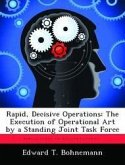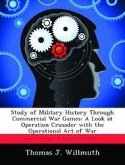Effectively applying operational art and battle command is a challenging task. Several factors associated with the operational level of war create an environment that is uncertain and complex. The expanding size, scope and depth of joint areas of operations place great demands on command and control systems. Future threats will use a wide variety of tactics and technologies to negate American military superiority. Political considerations directly influence operational level planning and execution. Joint operations involve a wide range of land, air, sea, informational, and space capabilities. Integrating these capabilities into a synchronized concept of operation is a complex undertaking. A large number of actors influence operational actions. These actors include nongovernmental organizations, coalition partners, international organizations, and the media. Planning and conducting operations is this environment requires commanders and staffs that are skilled in operational art According to Joint Publication 1-02, operational art is the employment of military forces to attain strategic and/or operational objectives through the design, organization, integration, and conduct of strategies, campaigns, major operations, and battles. Operational art, as all forms of art, is an act of creation. The operational commander's vision is the source of creation that leads to the campaign plan. According to Field Manual 3-0, this process of creating a vision for a future operation is called battlefield visualization. Exceptional commanders can visualize the necessary steps to achieve the mission, anticipate opportunities, and estimate how their major operations will develop before they ever make contact with the enemy. Effective visualization places high demands on conceptual competencies. A central issue for the Army is how to provide an educational system that develops the necessary cognitive and conceptual skills in future operational commanders. The purpose of this monograph
Hinweis: Dieser Artikel kann nur an eine deutsche Lieferadresse ausgeliefert werden.
Hinweis: Dieser Artikel kann nur an eine deutsche Lieferadresse ausgeliefert werden.








